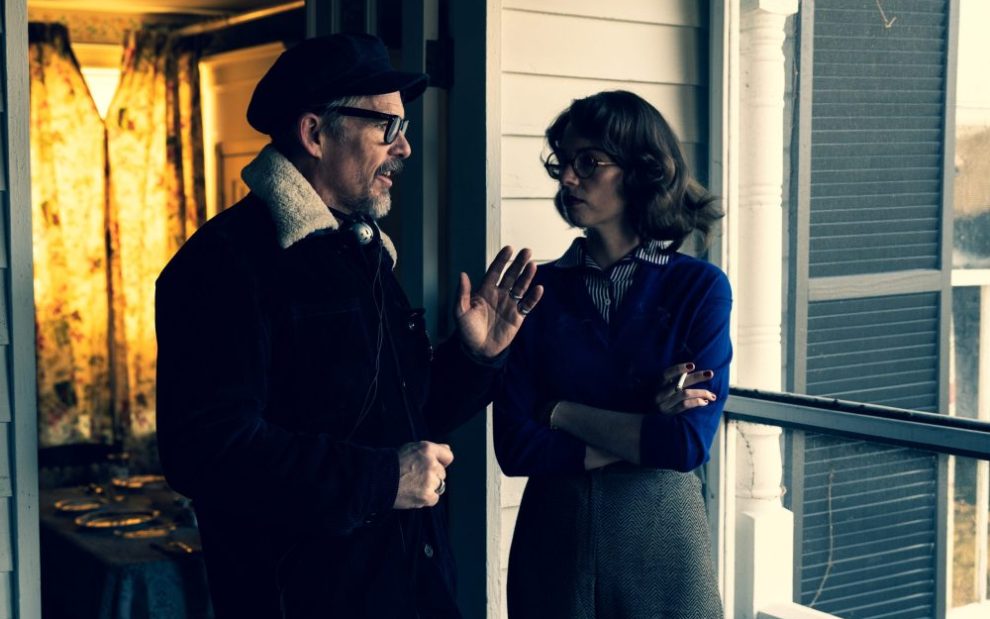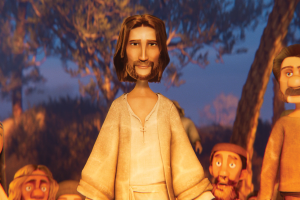One of the more intriguing questions about the new Flannery O’Connor film Wildcat is how it came about in the first place. Directed and co-written by actor Ethan Hawke, and starring his daughter Maya in the main roles, the non-linear, innovative film focuses on the life and work of celebrated Catholic writer Flannery O’Connor. But Wildcat is much more than a typical biopic. Although it includes a number of scenes from O’Connor’s real life and experience, it also features Maya Hawke portraying the protagonist in selected O’Connor short stories, including “A Good Man is Hard to Find,” “Parker’s Back,” and “Good Country People.” Much of Ethan Hawke’s more recent film work touches on transcendent themes, and while he is familiar with O’Connor’s work, it was his daughter Maya’s idea to bring the Wildcat project forward.
Maya first encountered O’Connor’s novels and short stories as a high school sophomore. Inspired by the author’s fiction and her ideas about using narrative art to give glory to God, Maya adapted material from O’Connor’s A Prayer Journal (Farrar, Straus and Giroux) as part of her audition for admission to New York’s Julliard School for the Arts. Maya eventually approached her father and his film production company with the idea to put the film together.
In various interviews since the film went into production, Maya said she was influenced by O’Connor’s struggle to produce good fiction, not just to establish her literary bona fides, but to highlight such transcendental values as suffering, grace, and redemption. Maya elaborated on her inspiration for the Wildcat film in a recent YouTube presentation: “I felt so ‘seen’ in O’Connor’s work,” she said in the video, adding that she was further motivated by O’Connor’s musings on the use of art and creativity for purposes other than literary renown.
Maya was confident her father would be receptive to the film idea. Although raised in the Episcopalian faith, Ethan has often described himself as “a wannabe Catholic.” Furthermore, he was already well disposed to the art of Flannery O’Connor, thanks in part to his mother’s job selling textbooks to Atlanta-area colleges.
At a recent screening of Wildcat at Fordham University in New York, Ethan Hawke described how his mother’s work meant there were always Flannery O’Connor books available in the Hawke household. “So I was always intrigued by Flannery O’Connor, but the idea of making a film didn’t start with me,” Ethan said. “It was Maya’s idea.”
The next key step in the realization of Wildcat was the search for a sympathetic producer. Enter Eric Groth, head of Renovo Media Group and president of ODB Films, an award-winning not-for-profit Catholic video production ministry. In January 2016, ODB released its first feature film, Full of Grace. The company followed that up with the Paul, Apostle of Christ, a 2018 release which won wide acclaim. It might be an exaggeration to describe Eric Groth as an exclusively Catholic filmmaker, but it wouldn’t be too far off the mark. Like Ethan Hawke, Groth was well disposed to O’Connor’s life and fiction, and he had no hesitation in furthering the project along.
According to Groth, there were many advantages in the Ethan-Maya father-daughter relationship in conceptualizing the film. “There were many things that attracted me to the project,” Groth says. “I’ve always appreciated Ethan Hawke, and I think he’s one of the best filmmakers of my generation. I was very attracted to the fact that [Flannery O’Connor] was a Catholic figure, and we could tell her story and bring faith in naturally without having to force it. And then I was attracted by the idea of O’Connor as a Catholic writer who needs to be celebrated.”
Groth says he and the Hawkes did not set out initially to make a “faith-based film.” Although previous Groth productions had faith elements, the producer looks to avoid producing art to proselytize or to preach to the choir. “It would be easy to make films that make the church happy, but it’s harder to make the kinds of films that can draw all people together and to treat the concepts of faith, suffering, redemption, and grace honestly,” Groth says.
Ironically perhaps, Catholic reactions to the release of O’Connor’s short stories in the early 1950s were not positive. Some critics were scandalized by the author’s use of violence, the grotesque, and earthy realism.
Matt Bryant Cheney is a southern literature scholar and Assistant Director of the Judith Anderson Herbert Writing Center at the University of Tennessee in Knoxville. He watched the film in early June. “The film, I think, captures the real oddity and distinctiveness of O’Connor’s humor and subject matter, and I can only imagine this sparking the curiosity of viewers who are not inherently repulsed by such things,” Bryant Cheney says.
For his part, Ethan Hawke’s commitment to celebrating Flannery O’Connor’s art in film outweighs any thoughts of hagiography and commercial success. He says that while O’Connor might not be a popular subject for contemporary movie-going audiences, there were other considerations at play with Wildcat. “If we wanted to make a hit movie, we could have made a film about zombies or a Stephen King horror story,” Hawke says. “But there’s a secret agenda here in that we think [O’Connor’s] work is interesting and we want to share it with people. And maybe this film needed to be made to make that happen.”
Hawke describes the film production project as a “very beautiful moment” in his and Maya’s lives. Maya, Hawke says, fell in love with O’Connor’s prayer journal, as it spoke to many of the same thoughts about faith and the divine as Maya did in her early 20s.
“We made it for a literary audience who absolutely love and adore Flannery,” Hawke adds. “It has been fun to show the film to people who really do have a deep appreciation for Flannery [and] to have them come back and have dialogue about it. There are a lot of seekers out there. And Flannery O’Connor was a truth seeker, and there are a lot of people from every walk of life who are interested in that, and they can find it in her.”
At least one Flannery O’Connor authority is not surprised that young Maya Hawke used O’Connor’s fiction and prayer journal as a springboard to the film project. Angela Alaimo-O’Donnell is a professor of English literature, American Catholic Studies, and creative writing at Fordham University in New York. She is author of Radical Ambivalence (Fordham University Press), a study of racist elements in O’Connor’s personal correspondence, and Flannery O’Connor: Fiction Fired By Faith (Liturgical Press), a short biography of the celebrated writer. Alaimo O’Donnell has also written several books of poetry, including Andalusian Hours (Paraclete Press), a collection of 101 poems “channeling the voice” of O’Connor.
“I think in the process of making this film, and getting to the nitty-gritty of who O’Connor was, Maya developed a deep sense of her spirituality and it comes through in the film,” Alaimo O’Donnell says. “It’s almost as though [she] could not act that role as well as she does without identifying in some way with O’Connor’s deep spiritual search—her spiritual agony really.”
For Bryant Cheney of the Flannery O’Connor Society, Wildcat holds abundant promise. “I think Flannery O’Connor is the finest short story writer we have produced in the United States, and I am very much in favor of her work being read widely in a variety of contexts,” he says.
He anticipates that Wildcat’s appeal will go well beyond Catholic viewers. “I don’t see how Wildcat would only appeal to Catholics. I don’t even think I would call it a ‘Catholic film’ so much as a film about an incredible writer—who happens to be Catholic—from a unique time and place navigating a unique set of circumstances.”
“My fear would be that the given O’Connor’s diminished stock with many non-Christian readers and scholars, Catholic audiences just happen to be the most ready and interested to engage with her work,” he adds. “This can create an unhelpful perception that O’Connor’s work should only persist as always only mediated by Catholic scholars and boosters. But despite the ways Hawke permeates the film with O’Connor’s faith life, the film did not strike me as moralizing or preachy. Faith in the film is, more or less, an important feature of this person’s life, and we can’t really understand Flannery O’Connor the person and artist without paying at least some attention to her Christian beliefs and practices.”
Father Damian Ference, a priest in the Cleveland diocese, and an associate professor of philosophy at Borromeo Seminary, is also author of the new book Understanding the Hillbilly Thomist (Word on Fire) which outlines O’Connor’s heavy reliance on the life and writing of St. Thomas Aquinas as the grounding of much of her fiction.
Ference lauded the film, particularly Maya Hawke, for capturing the “raw, desperate, and holy desire” of Flannery O’Connor to both serve God and be a great writer. “I know many people who have tried to read O’Connor because they have heard that she’s a fantastic writer, but they have a hard time understanding her fiction because it is strange and weird,” Father Ference says. “I think Wildcat is a lot like O’Connor’s fiction, in that it will receive similar reactions because many people will not understand what they are seeing. But the more you know Flannery and the more you know about her, the more you’ll appreciate the film.”
The film will likely rekindle interest in Flannery O’Connor’s life and art within the Catholic community. It will be curious to note any more lasting impacts of the film. Susan Srigley, a professor of religions and cultures at Nipissing University in North Bay, Ontario and a Flannery O’Connor scholar, says O’Connor wasn’t inspired to write fiction about Catholics or even for Catholics. Srigley referred to an O’Connor essay “Novelist and Believer,” in which the writer discussed the novelist’s duty to create believable scenarios. “And as a writer who knew that her audience was, more often than not secular, [O’Connor] understood that her art needed to transcend the boundaries of any specific set of beliefs,” Srigley says. “Perhaps this is why her fiction has such a broad appeal for non-Catholics, including agnostics and atheists.”
O’Connor’s prayer journal can help shed light on O’Connor’s work. “I have found in teaching O’Connor to my university students that her fiction makes more sense to them when they read The Prayer Journal,” Srigley says. “It’s as though a portal opens into an interior world that is replete with more questions than answers, and this allows them to recognize in her fiction a search for meaning that goes deeper than doctrinal formulations.”
Srigley suggested that what Ethan and Maya Hawke have revealed about Flannery O’Connor with their film, and what gives her such broad secular appeal, is the depiction of O’Connor “as a fellow traveler in the search for meaning, with art that seeks to fathom the mystery of existence.”
Alaimo O’Donnell hopes Wildcat might lead to something more lasting than positive reviews and increased sales of O’Connor’s writings. It might get more people musing about suffering, redemption, and grace.
“O’Connor deals with ordinary, sinning people as she finds them, and in the settings where she finds them—gas stations, backwoods cabins, dairy farms, small Southern towns, on trains and buses, at freak shows, in the doctor’s office. No place is off limits. And no place is so secular that it won’t allow for incursions of grace. O’Connor in her stories makes grace available to the most undeserving of people. It’s a generous theology. If these horrible people can be forgiven for their sins, the reader thinks, surely mine can be forgiven as well.”
Image: Kevin Wandra, Carmel Communications.













Add comment